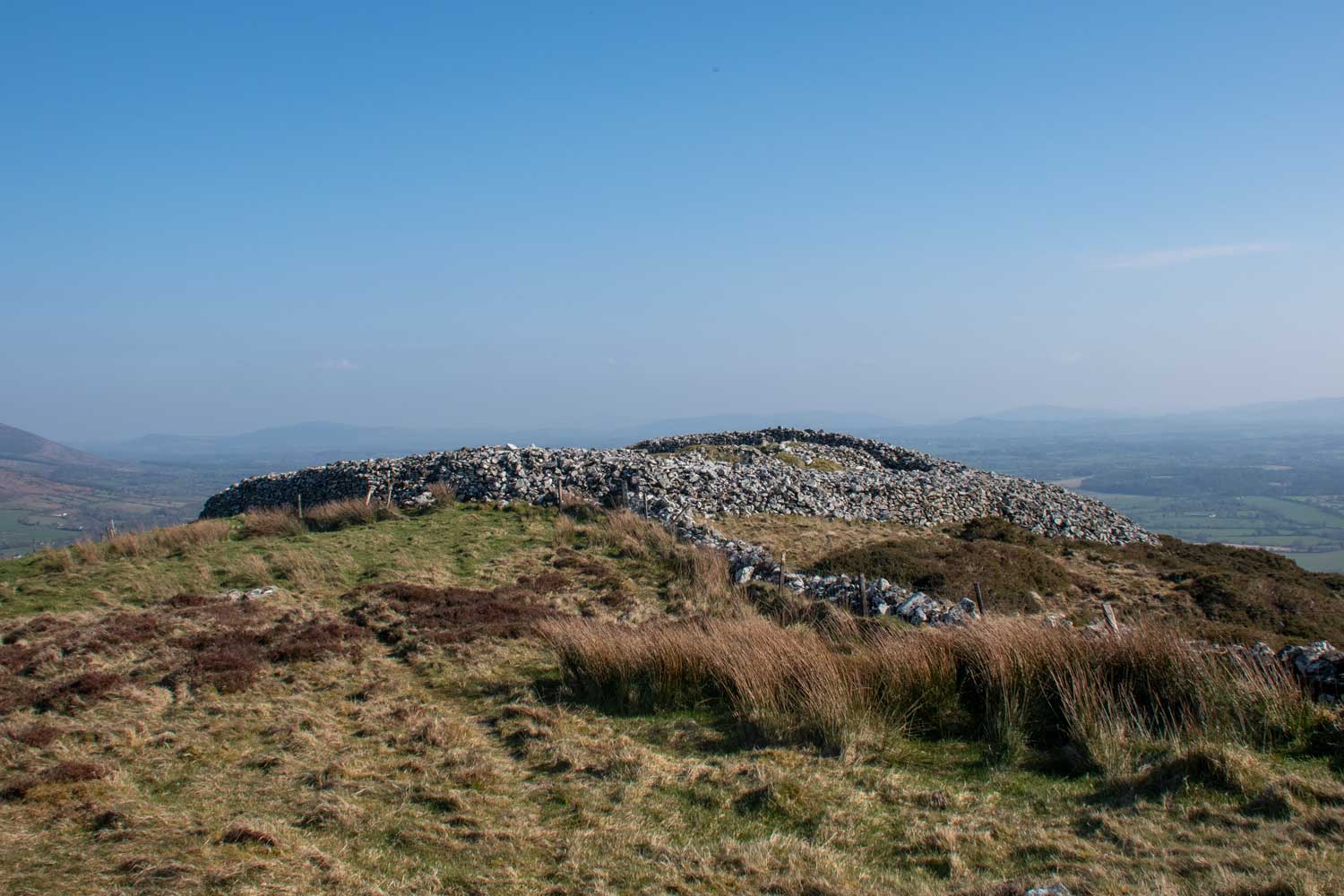Rathcoran

Location: Coolinarrig, Co. Wicklow
Classification: Hillfort
SMR Code: WI027-026003-
Rating:
At the summit of Baltinglass Hill is an open multi-chambered cairn, with the remnants of at least three tombs at its centre. The whole site is surrounded by the remnants of a Bronze Age hill fort whose builders may have used some of the stones from the cairn. The main tomb is situated at the north side of the cairn, it contains a 3 metre passage, complete with roof slabs, leading to a chamber with three narrow compartments and a basin shaped stone. On the south side of the cairn is another chamber with three compartments, two of its stones are faintly decorated. Another chamber stands to the east of the main tomb and on the northwest are the remnants of a tomb structure with a corbelled roof.
It is believed that the cairn would have dated from the same time as Newgrange, between 3500 - 3000BC. The surrounding hillfort dates from around 1000 BC. Known as Rathcoran, the name derives from 'Ráth Charnáin' - 'ring fort of the cairn'. During the excavation cremated bone, pottery, many flint scrapers and large amounts white quartz were found. The recesses of the main tomb contained a large amount of burnt bone, three flint scrapers were also found within the chamber. Other finds consisted of bone pins, bone needles and also a polished egg shaped white stone 2cm in diameter along with a polished axe and a javelin head.
The saga Bóruma Laigen (Cattle-tribute of the Leinstermen) is based on historical events of the seventh century and tells the story of wars between rival kings in west Wicklow. One incident involves the raths around Baltinglass. The hero, Brandub, was threatened by Cummascach, a king of the dominant Uí Néill clan. Cummascach demanded his traditional right to sleep with Brandub's wife. Brandub pretended to agree but secretly sent his wife away, then allowed his enemy into the hall at Belach nDubthaire (Baltinglass). That night, while the king and his three hundred followers feasted, Brandub set fire to the hall and slew his enemies as they fled.
Description
At the summit of Baltinglass Hill is an open multi-chambered cairn, with the remnants of at least three tombs at its centre. The whole site is surrounded by the remnants of a Bronze Age hill fort whose builders may have used some of the stones from the cairn. The main tomb is situated at the north side of the cairn, it contains a 3 metre passage, complete with roof slabs, leading to a chamber with three narrow compartments and a basin shaped stone. On the south side of the cairn is another chamber with three compartments, two of its stones are faintly decorated. Another chamber stands to the east of the main tomb and on the northwest are the remnants of a tomb structure with a corbelled roof.
History
It is believed that the cairn would have dated from the same time as Newgrange, between 3500 - 3000BC. The surrounding hillfort dates from around 1000 BC. Known as Rathcoran, the name derives from 'Ráth Charnáin' - 'ring fort of the cairn'. During the excavation cremated bone, pottery, many flint scrapers and large amounts white quartz were found. The recesses of the main tomb contained a large amount of burnt bone, three flint scrapers were also found within the chamber. Other finds consisted of bone pins, bone needles and also a polished egg shaped white stone 2cm in diameter along with a polished axe and a javelin head.
Folklore
The saga Bóruma Laigen (Cattle-tribute of the Leinstermen) is based on historical events of the seventh century and tells the story of wars between rival kings in west Wicklow. One incident involves the raths around Baltinglass. The hero, Brandub, was threatened by Cummascach, a king of the dominant Uí Néill clan. Cummascach demanded his traditional right to sleep with Brandub's wife. Brandub pretended to agree but secretly sent his wife away, then allowed his enemy into the hall at Belach nDubthaire (Baltinglass). That night, while the king and his three hundred followers feasted, Brandub set fire to the hall and slew his enemies as they fled.
Accessibility Rating: Difficult
There are no facilities at this site.
Accessibility
Accessibility Class: Difficult
Facilities
There are no facilities at this site.
Map
Users should note that the Monumental Ireland application and website are information guides only and do not act as an invitation to enter any of the properties or sites listed. No responsibility is accepted by the creators of the Monumental Ireland application for any loss, injury or inconveniences sustained as a result of using it.










